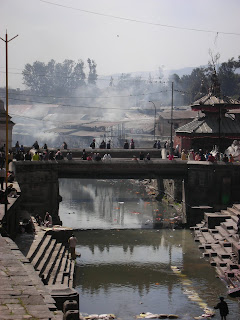Today was one of the important Hindu festivals in Nepal (and worldwide) – Maha Shivaratri. Maha Shivaratri is a festival for Shiva’s birthday, celebrated annually around this time of year. Literally translated, Shivaratri means “the great night of Shiva.” The celebration began last night at midnight and ran through the entire length of today. It officially takes place on the night of the 13th day and during the 14th day of the month of Falgun in the Hindu calendar.
The festival is principally celebrated by the offering of bilva leaves to Lord Shiva, day-long fasting, and holding vigil throughout the night. It is considered an occasion for married women to pray for the well-being of their husbands and sons and for unmarried women to pray for a husband like Shiva, who is considered the ideal husband. Many people often bathe in the Bagmati River (or rather, cover themselves in dirt and grime from the River), which is considered to be spiritually cleansing.

Thousands of people throng to Pashupatinath on Maha Shivaratri, which is an entire temple complex dedicated to the Lord Shiva, where they leave offerings at the Pashupatinath Temple.

Another tradition of Maha Shivaratri, in addition to visiting Pashupatinath, bathing in the Bagmati, and imbibing in cannabis, is for children to place ropes across the road to stop traffic. They then ask for a small “toll” before allowing the travelers – pedestrians, motorbikes, and cars alike – to pass.

Luckily, I had been prepared for this ritual, or we would probably have been very confused during our walk today. The children are normally gathered in small groups, and we only saw young children participating. A few of the children could be quite demanding (one walked up to Katie and said “You give me money!”), but for the most part, they are very excited when you give them a few rupees. It really seems to make their day. Then they gladly drop the rope to the road and allow passage.

There are quite a few people, however, who very much disagree with the practice, as they feel it teaches children that begging for money is appropriate. Many Nepalis look down upon children who are begging in the streets or at local squares and instruct foreigners to not provide any sort of money or food items to the children, as it only leads to a downward spiral. While I agree with this, I do feel that, on one day of the year, children should be permitted their fun rituals, as long as parents remind them on the other days of the year about the need for hard work in order to succeed. After all, most children in the United States participate in trick-or-treat every year when they are young. When you think about it, is there really much of a difference?


No comments:
Post a Comment